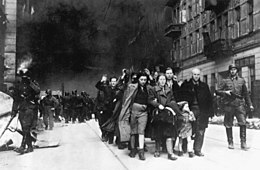猶太區起義
| 猶太區起義 | |
|---|---|
 | |
| 別名 | 猶太區起義 |
| 地點 | 納粹佔領區 |
| 日期 | 1941–1943年,第二次世界大戰期間 |
| 事件類型 | 武裝起義 |
第二次世界大戰期間的猶太區起義(又稱猶太人區起義)是1941年至1943年期間一系列反抗納粹德國的武裝起義的總稱,發生在納粹德國在歐洲佔領區中建立不久的諸多猶太區(Ghetto)中。隨着1939年9月德蘇入侵波蘭,波蘭猶太人從一開始就被納粹當局針對。德國用了幾個月的時間在波蘭佔領區劃分了數百個猶太區,強迫猶太人在這些區域中生活。建立猶太區是德國將猶太人從公共生活中移除的官方計劃的一部分,旨在從經濟上剝削猶太人。[1]過高的羈押人數、糟糕的衛生條件以及食物匱乏共同導致了猶太區居民的高死亡率。[2]在大多數城市中,猶太地下抵抗運動立即開始發展,但猶太區化管理極大限制了抵抗運動的可用資源。[3]
猶太區抵抗戰士在猶太人大屠殺最致命的階段——納粹於1942年發起的「萊茵哈德行動」時期武裝鬥爭,反抗納粹將關押的所有男女老幼遣送至滅絕營實施大規模滅殺的「最終解決方案」。[3]
歷史
[編輯]波蘭猶太人的武裝抵抗在1939年時的波蘭-蘇聯邊境兩側100多個地點爆發過,絕大多數發生在波蘭東部。[4][5]一些起義是有組織的大規模起義,還有一些是較小規模的自發抵抗。猶太人大屠殺期間最為著名、規模最大的猶太起義是1943年4月19日至5月16日的華沙猶太區起義[6]以及同年8月的比亞韋斯托克猶太區起義。在華沙猶太區起義期間,56,065名猶太人被當場擊斃,或是被抓捕後由大屠殺列車押送至滅絕營;華沙猶太區被夷為平地。[7][8]比亞韋斯托克猶太區中的1萬人被押上大屠殺列車、2000人被就地處決後, 猶太區地下武裝組織了一場大規模起義,導致該區被封鎖長達一個月。[9]有一些猶太區的抵抗運動導致整個猶太區被焚毀,譬如位於現在烏克蘭境內的科洛梅亞猶太區。[10]在另一些起義後(譬如米佐什猶太區起義),納粹大規模射殺婦女兒童以報復猶太人起義。[11][12]
猶太人大屠殺期間主要的猶太區起義
[編輯]猶太人大屠殺期間有5座大城市、45個主要城鎮、5座主要集中營/滅絕營、以及至少18處勞改營發生了猶太起義。[13]一些重要的猶太區起義包括:[14]
- 1942年9月3日拉赫瓦猶太區起義
- 1942年10月14日米佐什猶太區起義
- 1943年1月10日明斯克馬佐維耶斯基猶太區囚犯暴動
- 1943年4月19日-5月16日華沙猶太區起義,由猶太戰鬥組織與猶太軍事聯盟組織的大規模起義
- 1943年6月25日-30日琴斯托霍瓦猶太區起義
- 1943年8月3日本津猶太區起義,又稱本津—索斯諾維茨猶太區起義
- 1943年8月16日-17日比亞韋斯托克猶太區起義,由反法西斯軍事組織發起的起義
一些其他的猶太區在最終被納粹消滅時也遇到了不同程度的武裝抵抗:
參見
[編輯]註解
[編輯]- ^ Wolf Gruner, Jewish Forced Labor Under the Nazis: Economic Needs and Racial Aims, 1938-1944, Cambridge University Press: 249–250, 2006 [2019-01-19], ISBN 0521838754, (原始內容存檔於2017-07-30),
By the end of 1940, the forced-labor program in the General Government had registered over 700,000 Jewish men and women who were working for the German economy in ghetto businesses and as labor for projects outside the ghetto; there would be more.
- ^ Marek Edelman. The Ghetto Fights. The Warsaw Ghetto: The 45th Anniversary of the Uprising. Literature of the Holocaust, at the University of Pennsylvania. [2013-10-02]. (原始內容存檔於2009-11-25).
- ^ 3.0 3.1 Resistance in Ghettos. Jewish Uprisings in Ghettos and Camps, 1941–1944. Holocaust Encyclopedia. 2013-06-10 [2014-01-09]. (原始內容存檔於2012-05-14).
- ^ Shmuel Krakowski, Armed Resistance, YIVO, 2010 [2019-01-19], (原始內容存檔於2011-06-02)
- ^ Jewish Resistance. United States Holocaust Memorial Museum. 2011 [2014-01-09]. (原始內容存檔於2012-01-26) –透過Internet Archive.
- ^ April–May 1943, Warsaw Ghetto Uprising. Timeline of Events. United States Holocaust Memorial Museum. 2013 [2014-01-09]. (原始內容存檔於2014-01-09).
- ^ World War II: Warsaw Ghetto Uprising. Originally published by World War II magazine. 2006-06-12 [2014-09-04]. (原始內容存檔於2014-11-06).
See also: Stroop Report for supplementary data.
- ^ Marcin Wilczek. A Somber Anniversary. ZSSEDU. 2011-04-19 [2014-09-04]. (原始內容存檔於2016-03-15).
- ^ Sara Bender. The Jews of Bialystok During World War II and the Holocaust. The End of the Ghetto (UPNE). 2008: 253–263 [2019-01-19]. ISBN 1584657294. (原始內容存檔於2018-11-05) –透過Google Books preview.
- ^ Warsaw Ghetto Uprising. Holocaust Encyclopedia. Holocaust Memorial Museum, Washington DC. 2012 [2014-01-09]. (原始內容存檔於2012-10-28).
- ^ Eve Nussbaum Soumerai, Carol D. Schulz, Daily Life During the Holocaust (頁面存檔備份,存於互聯網檔案館), p. 124. ISBN 0313353093.
- ^ Photographs of the Mizocz shootings (頁面存檔備份,存於互聯網檔案館) in the USHMM collection (No. 17876, 17877, (頁面存檔備份,存於互聯網檔案館) 17878 (頁面存檔備份,存於互聯網檔案館), 17879). Retrieved 26 October 2015.
- ^ United States Holocaust Memorial Museum, Resistance during the Holocaust (PDF), The Miles Lerman Center for the Study of Jewish Resistance, p. 6 of 56 in current document, [2019-01-19], (原始內容存檔 (PDF)於2017-08-29).
- ^ Map of the Jewish uprisings in World War II (PDF file, direct download 169 KB). Yad Vashem. 2013 [2014-01-09]. (原始內容存檔 (PDF)於2013-07-18).
參見
[編輯]- 以色列猶太大屠殺紀念館網站上關於猶太武裝抵抗運動和起義的記述,2014年1月9日查詢
- JTA. 58,000 Jews Executed by Nazis in Kolomyja; Thousands Burned Alive. Archive. Jewish Telegraphic Agency. 1943-03-07 [2019-01-19]. (原始內容存檔於2021-03-28).
數百名猶太人仍留在猶太區內的藏身處。為了確保消滅這些人,蓋世太保的主管下令將猶太區焚燒殆盡,從而完成對克羅米亞「徹底的猶太人清洗」。(A few hundred Jews remained in their ghetto hideouts. In order to make certain that not a single one of them would remain alive, the chief of the Gestapo ordered the ghetto burnt down to the ground, thus finishing the process of making Kolomyja 「completely judenrein.」)




